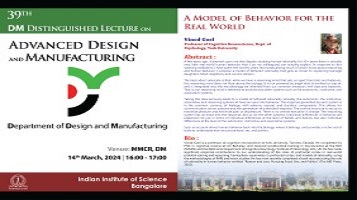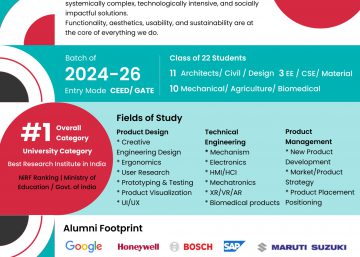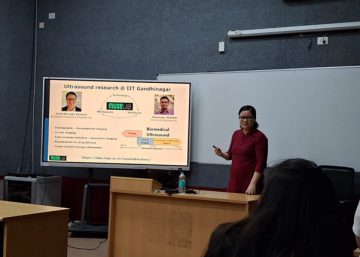39th DM Distinguished Lecture on Advanced Design and Manufacturing
Title: Tethered Rationality: A Model of Behavior for the Real World
Speaker: Prof. Vinod Goel, Cognitive Neuroscience, York University
(https://health.yorku.ca/health-profiles/index.php?mid=5905)
Date, time & venue:
14th March 2024 (Thurs),
4:00-5:00 PM at MMCR,
Department of Design and Manufacturing (erstwhile Centre for Product Design and
Manufacturing), Indian Institute of Science
MS Teams link: https://teams.microsoft.com/l/meetup-
join/19%3ameeting_NDFiMjIwNTUtMGE0My00MTA4LWI3ZDktZTAwOTBiZjU3MTIx%40thread.v2/0?context=%7b%22Tid%22%3a%226f15cd97-f6a7-41e3-b2c5-ad4193976476%22%2c%22Oid%22%3a%225d2073ee-8c2e-4d95-9de1-6f8eb8182ddd%22%7d
Abstract:
A few years ago, it dawned upon me that despite studying human rationality for 20+ years there is actually very little real-world human behavior that I (or my colleagues) can actually explain. In response to this sobering realization, I have spent the last few years reconceptualizing much of what I know about reasoning and human behavior. I propose a model of tethered rationality that gets us closer to explaining teenage daughters, Modi neighbors, & vaccine deniers.
The basic idea I advocate is that, while we have a reasoning mind that sets us apart from bats and baboons, this reasoning mind does not float above the biology. It is not powered by angel dust. It evolved on top of, & is integrated into, the neurobiology we inherited from our common ancestors with bats & baboons. That is, our reasoning mind is tethered to evolutionary older systems such as the autonomic, instinctive, & associative systems.
Taking this idea seriously leads to a model of tethered rationality whereby the autonomic, the instinctive, associative, & reasoning systems all have an input into behavior. The response generated by each system is in the common currency of feelings, with valence, arousal, & duration components. This allows for communication across systems and the generation of a blended response. The control structure is set up to maximize pleasure and minimize pain or displeasure. There is no central executive in charge. The reasoning system has an input into them response, but so do the other systems. Individual differences in behavior are explained not just in terms of individual differences at the level of beliefs and desires, but also individual differences at the level of the autonomic, instinctive, and associative systems. Such an account drives human behavior back into the biology, where it belongs, and provides a richer set of tools to understand how we pursue food, sex, & politics.
Brief Bio:
Vinod Goel is a professor of cognitive neuroscience at York University, Toronto, Canada. He completed his PhD in cognitive science at UC-Berkeley, & received postdoctoral training in neuroscience at the NIH (NINDS) & the Wellcome Department of Cognitive Neurology, Institute of Neurology, UCL, UK. He has made significant empirical contributions to our understanding of the roles of prefrontal cortex in real-world problem solving and reasoning, hemispheric asymmetry in prefrontal cortex, and models of rationality, using the methodologies of fMRI and lesion studies. He has most recently completed a book reconstructing the role of rationality in human behavior entitled “Reason and Less: Pursuing Food, Sex, and Politics” (The MIT Press, 2022).
For more information, please visit: https://www.yorku.ca/vgoel/



